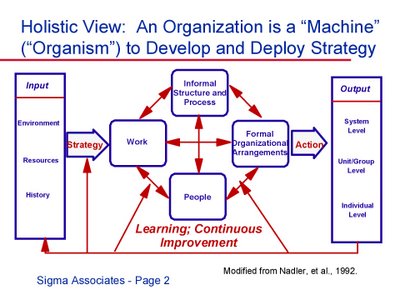 The diagram above is one that I often used in my consulting practice. It means to illustrate the linkage between strategy and organization. Let me expound a bit on this thought.
The diagram above is one that I often used in my consulting practice. It means to illustrate the linkage between strategy and organization. Let me expound a bit on this thought.The diagram, which I took from the Nadler et al. paper and them modified a bit, by adding the learning/continuous improvement back loop, can be described as follows:
An enterprise (whether profit or non-profit) has a variety of features described at the left, such as history, resources, the environment in which it operates, etc. In order to evolve and progress it develops a strategy for change and improvement. This strategy may be explicit or implicit.
[An explicit strategy is self-evident. An implicit strategy can arise from the lack of explicit strategy, in the extreme, just "going with the flow", that is, abdicating strategic responsibilities of management. Sometimes, managers think that they have an explicit strategy (they have, after all, written something down) but actually operate on the basis of an implicit strategy of ignoring the explicit strategy in their decision-making.]
An organization is viewed as a machine or organism for translating strategy into action. Here Nadler, et al. and I use the organization in the broad sense as being comprised of the four elements shown in the central part of the diagram. Organization is the synthesis of these four factors:
- Formal Organizational Arrangements: This the the formal structure of the enterprise describing who reports to whom, etc., the "org chart", if you will. Too many enterprises still think that this is the real organization, which it is not.
- Work: The processes (often formalized) which state how particular tasks are to be performed. Often management sets objectives which focus on measurements which focus on how this work is done, e.g., measuring the number of widgets produced per hour.
- Informal Structure and Processes: Here we are looking at the cultural infrastructure of an organization, how its history either facilitates or blocks work and progress. This is an important "real world" element which is often difficult to understand since much of this is implicit rather than explicit.
- People: These are the individuals which populate the organization. People have their strengths and weakness, their skills and quirks.
I would add the observation that as strategy changes, it is very likely that organization, in the large sense of that world, will have to change both within the boxes and in re-optimizing its congruency.
In any case, the organization converts strategy into action and the outputs (outcomes) have to be measured at various levels, as shown at the right of the diagram. The system of measurement has to be holistic and consistent with the desired strategic outcomes. To the extent that the measurements are wrong, the lessons learned will potentially be flawed.
This brings us to the back loop titled "Learning; Continuous Improvement" shown at the bottom of the diagram. It is unlikely that we have nothing to learn from what really happens as we try to translate strategy into results. Thus, effective feedback loops, to input, strategy and organization are essential. To the extent that we learn the right lessons from real experience we can often improve matters. However, if we draw false lessons, we are likely to adapt dis functionally. Another risk is that we impute lessons too quickly or too slowly, resulting in volatile strategy and micromanagement in the first case and lethargy in the second.
I hope that this lengthy exposition is useful to some of you. As always, I would appreciate your feedback.
No comments:
Post a Comment